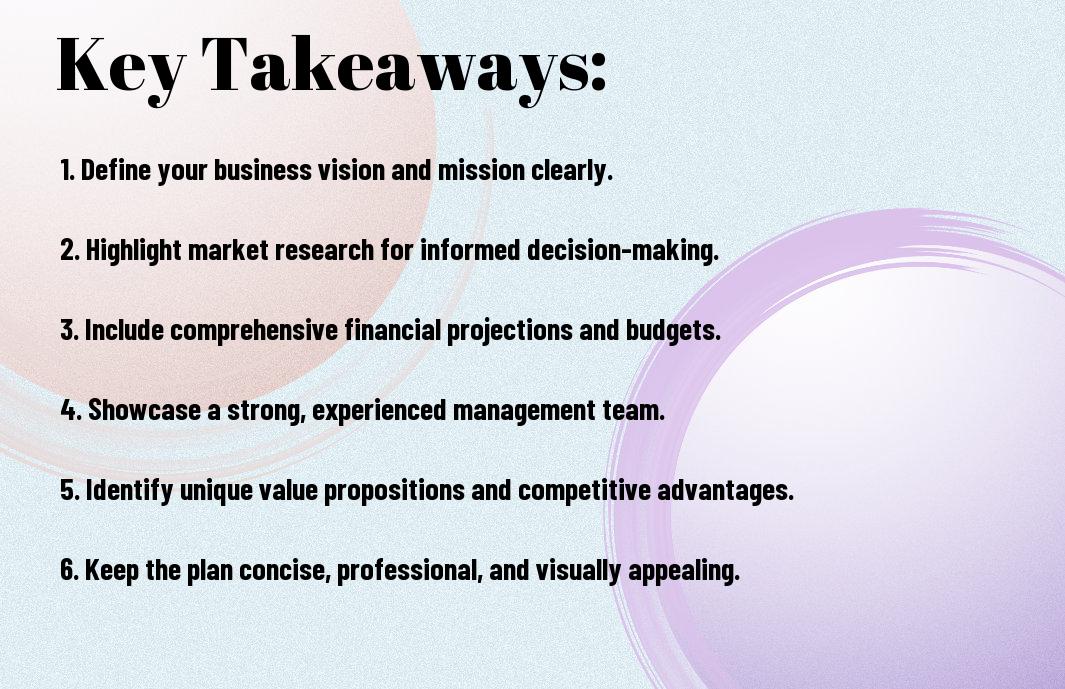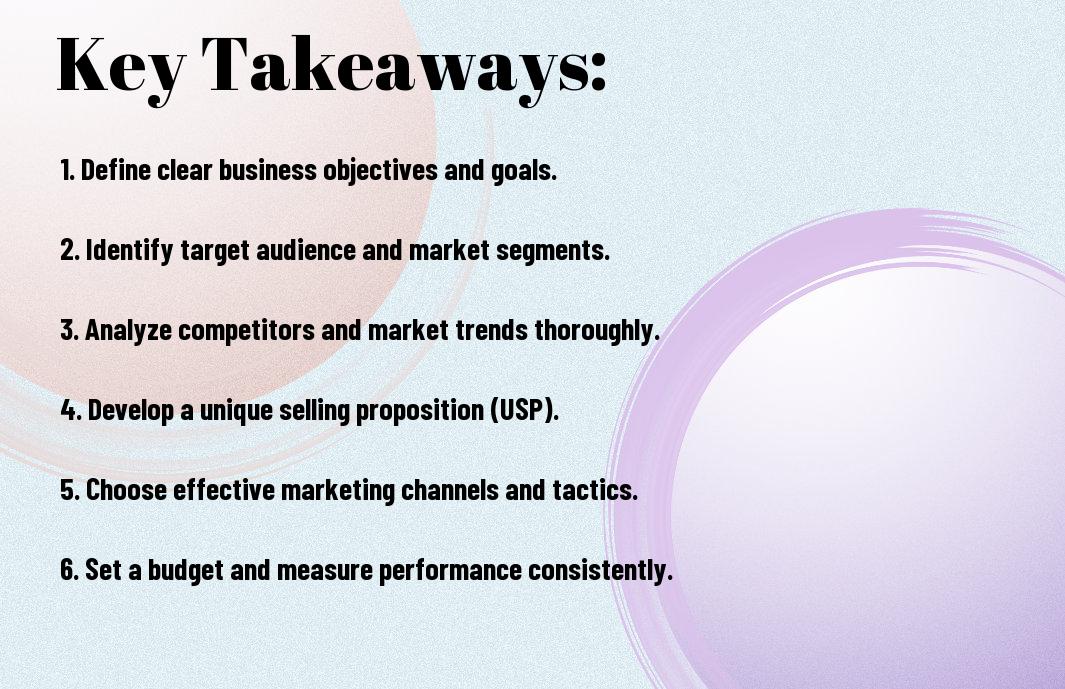Plan to distinguish your business from the competition by developing a compelling business plan that captivates potential investors. Your plan should not only outline your business goals but also demonstrate a clear strategy for growth and profitability. By focusing on key elements such as market analysis, financial projections, and a unique value proposition, you can create a persuasive narrative that aligns with investor expectations. In this guide, you will learn how to craft a business plan that showcases your vision and increases your chances of securing funding.

Key Takeaways:
- Define your vision: Clearly articulate your business goals and long-term vision to provide potential investors with a roadmap of your plans.
- Market analysis: Conduct thorough research on your target market, competition, and industry trends to demonstrate a solid understanding of the landscape.
- Financial projections: Include realistic financial forecasts and key performance indicators to showcase your potential for profitability and growth.
- Unique value proposition: Highlight what sets your business apart, addressing how your product or service meets a specific need in the market.
- Content organization: Structure your business plan in a logical, clear format to make it easily accessible for investors, keeping the narrative engaging.

Understanding Your Audience
For a successful business plan, you need to grasp the perspectives and expectations of potential investors. This involves recognizing their priorities and what motivates them to choose one venture over another. By aligning your proposal with their mindset, you can create a compelling narrative that resonates with your target audience and enhances your chances of securing funding.
Identifying Potential Investors
An effective approach to identifying potential investors is by researching those who have previously invested in your industry. Analyze their preferences and interests, as they will differ from one investor to another. Targeting the right investors who align with your venture can significantly improve your chances of gaining their support.
Tailoring Your Plan to Different Investor Types
Due to the diverse nature of investors, you should customize your business plan to cater to their specific interests and needs. Distinguishing between angel investors, venture capitalists, and private equity firms, for example, can help you shape a more appealing proposal. Consider the following:
- Angel investors typically seek high-growth potential and innovation.
- Venture capitalists often focus on scalability and market size.
- Private equity firms prefer established businesses with solid returns.
- Strategic investors look for synergy with their existing operations.
- Impact investors prioritize social and environmental returns.
Recognizing these differences allows you to focus on what matters most to each investor type, thus increasing your odds of attracting their interest.
| Investor Type | Key Focus |
| Angel Investors | High-growth potential |
| Venture Capitalists | Scalability |
| Private Equity Firms | Established businesses |
| Strategic Investors | Synergy opportunities |
To effectively engage different types of investors, tailor your messaging and financial projections accordingly. Personalize your pitch by emphasizing areas that align with their investment strategies. This can include highlighting market trends, growth forecasts, or social impact, depending on the investor’s focus. Additionally, enhance your plan by:
- Using industry-specific language.
- Incorporating relevant case studies.
- Outlining your team’s expertise and experience.
- Providing well-structured financial models.
- Addressing potential risks and mitigation strategies.
Recognizing these factors will significantly elevate your business plan and make it more appealing to diverse investors.
Defining Your Business Vision
One effective way to draw in investors is by clearly defining your business vision. A well-articulated vision provides a roadmap for your company’s future and demonstrates to investors that you have a clear direction. To learn more about crafting a business plan that resonates with potential backers, explore the 7 steps to create a business plan that will wow investors – Sage.
Crafting a Compelling Mission Statement
At the core of your business vision is your mission statement, which succinctly conveys your purpose and the value you bring to customers. A compelling mission statement not only inspires your team but also attracts investors who align with your goals and values. Be concise and authentic to resonate with your audience.
Setting Achievable Goals
Defining your business objectives is vital for guiding your efforts and measuring success over time. Setting achievable goals helps you outline a clear path toward reaching your vision, allowing you to track progress and make necessary adjustments to your strategy.
With actionable and specific short-term and long-term goals in place, you can communicate to investors that you have a realistic approach to growth. Break down your objectives into measurable targets, and regularly evaluate your performance against them. This process not only keeps you focused but also reassures potential backers that your business is on a sustainable trajectory.
Conducting Market Research
Once again, conducting market research is fundamental in crafting your business plan to attract investors. This stage allows you to understand industry dynamics and validate your business concept. By leveraging data and insights, you can demonstrate your knowledge and readiness to potential stakeholders. For more insights on this process, check out How to Write a Convincing Business Plan for Investors.
Analyzing Industry Trends
Among the first steps in your research should be analyzing industry trends. Stay updated on shifts in consumer preferences, technology, and economic factors that can affect your market. By showcasing these trends, you can illustrate the potential growth of your business and instill confidence in your ability to adapt and thrive.
Identifying Target Market and Competition
Between understanding your competition and defining your target market, you sharpen your strategy for attracting investment. Identifying your audience allows you to tailor your offerings, while analyzing competitors lets you position your business effectively in the market.
At this stage, probe deep into demographic data, customer behavior patterns, and your competitors’ strengths and weaknesses. By creating detailed customer personas and conducting SWOT analysis on your competitors, you will clarify your unique value proposition. This analysis is vital for investors as it highlights your market insight and business viability, ensuring that you stand out in a crowded marketplace.
Developing a Robust Financial Plan
Your financial plan is a key component of your business plan that demonstrates to investors how you intend to manage funds and achieve profitability. This plan not only showcases your revenue generation strategy but also outlines your expense management, helping to secure investor confidence in your venture’s sustainability and growth potential.
Creating Financial Projections
Among the most important elements of a financial plan are your financial projections. These forecasts provide insights into your expected revenues, expenses, and cash flow over the next few years. By presenting realistic and data-driven estimates, you cultivate trust among potential investors in your business’s financial viability.
Outline Funding Requirements
For investors, understanding your funding requirements is vital as they evaluate the feasibility of your business. Clearly outlining how much capital you need and what it will be used for enhances your credibility and helps investors visualize the potential return on their investment.
Consequently, being specific about your funding requirements can significantly affect investor interest. Break down the amounts needed for different areas such as operational costs, marketing, and expansion. Additionally, explaining why these funds are necessary to achieve your goals and how they will impact your overall growth can strengthen your proposal, making it more compelling for potential investors.
Structuring Your Business Plan
Unlike other documents, a business plan requires a specific structure that effectively conveys your vision. Start with an executive summary before plunging into your business description, market analysis, organization and management details, service or product line, marketing strategies, funding requests, and financial projections. This clear roadmap not only conveys professionalism but also helps you remain focused on key objectives.
Essential Components of a Business Plan
Components of a strong business plan include an executive summary, a detailed description of your business, an analysis of your target market, organizational structure, and financial projections. Each section should serve a unique purpose, collectively showcasing how your business will succeed and how investors will benefit from being part of it.
Effective Presentation and Design
Business plans must be visually appealing and easy to read. Utilize headings, bullet points, and charts to present your information clearly. A polished design not only captures attention but also reflects your professionalism and seriousness about the venture.
Indeed, the presentation of your business plan plays a significant role in how it is received. A visually appealing layout can help draw investors in and make complicated concepts easier to understand. Consider incorporating graphics and charts to illustrate financial data and market trends, ensuring that your information is not only informative but also engaging. Consistency in fonts and colors throughout the document enhances readability and projects a cohesive brand identity, demonstrating your commitment to your business.
Preparing for Investor Meetings
All investor meetings require thorough preparation to increase your chances of success. Begin by researching the investor’s background and interests, tailoring your presentation to align with their investment goals. Rehearse your pitch, organizing your key points and data to enhance clarity. Moreover, ensure you have a strong understanding of your business model and financial projections, as these are often the focal points of investor discussions.
Pitching Techniques
Any successful pitch emphasizes clarity and engagement. Start with a compelling hook that captures attention, followed by a concise overview of your business and its value proposition. Utilize storytelling to create an emotional connection while integrating data to support your claims. Practice your delivery to project confidence, and don’t hesitate to showcase your passion for the project.
Handling Questions and Objections
Techniques for handling questions and objections effectively involve active listening and adaptability. Engage with your audience by welcoming their inquiries and demonstrating that you value their input. When faced with objections, maintain composure, and respond thoughtfully, providing clarity and evidence where needed. This approach showcases your expertise and reassures investors of your capability to navigate challenges.
Hence, anticipating potential objections and preparing thoughtful responses will further bolster your confidence during the meeting. Consider creating a FAQ document that addresses common concerns, allowing you to present your solutions succinctly. Being adaptable and open to feedback signals to investors that you are receptive and flexible, qualities important for any successful entrepreneur. This strategic groundwork will place you in a powerful position to turn any challenge into an opportunity during your discussions.
Conclusion
Taking this into account, crafting a compelling business plan is imperative for attracting investors to your venture. Focus on demonstrating a clear vision, solid market research, and a well-defined financial strategy. Ensure your narrative is engaging, highlighting how your business stands out within the market. By presenting a detailed yet concise plan that showcases your passion and expertise, you significantly increase your chances of gaining the interest and support of potential investors.
FAQ
Q: What key components should I include in my business plan to attract investors?
A: To attract investors, your business plan should include the following key components: an executive summary that outlines your business idea and objectives, a detailed market analysis that demonstrates your understanding of the industry and target audience, a description of your business model explaining how you intend to make money, a marketing and sales strategy that outlines how you plan to attract and retain customers, an organizational structure detailing your team and their qualifications, significant financial projections that show potential revenue and profitability, and a funding request if applicable. Each section should address questions and concerns that investors may have, presenting a compelling case for investment in your business.
Q: How can I conduct market research for my business plan effectively?
A: Effective market research for your business plan involves several steps. Start by clearly defining your target market and demographic. Utilize both primary and secondary research methods – primary research can include surveys, interviews, and focus groups with potential customers, while secondary research can involve analyzing existing data, industry reports, and competitors. Additionally, online tools and platforms can provide insights into market trends and consumer behavior. Summarize your findings in your business plan, showcasing the market size, growth potential, and competitive landscape to persuade investors that there is a viable opportunity for your business.
Q: What financial projections should be included in my business plan to impress potential investors?
A: Your business plan should include detailed financial projections typically covering a three to five-year period. Key components of these projections include sales forecasts, income statements, cash flow statements, and balance sheets. It’s also beneficial to provide a break-even analysis that indicates when you expect the business to become profitable. Be sure to use realistic assumptions based on market research and industry standards. Including detailed explanations for your projections and how you intend to achieve them can instill confidence in investors regarding the potential return on their investment.



